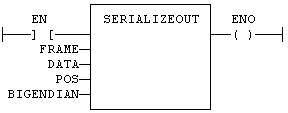SerializeOut
Function - Copy the value of a variable to a binary frame.
Inputs
|
Input |
Data type |
Description |
|
FRAME |
USINT |
Destination buffer - must be an array. |
|
DATA |
ANY(*) |
Source variable to be copied. |
|
POS |
DINT |
Position in the destination buffer. |
|
BIGENDIAN |
BOOL |
TRUE if the frame is encoded with Big Endian format. |
(*) DATA cannot be a STRING.
Outputs
|
Output |
Data type |
Description |
|
NEXTPOS |
DINT |
Position in the destination buffer after the copied data. |
Remarks
This function is commonly used for building a communication frame in binary format.
In LD language, the operation is executed only if the input rung (EN) is TRUE. The output rung (ENO) keeps the same value as the input rung.
The FRAME input must be an array large enough to receive the data. If the data cannot be safely copied to the destination buffer, the function returns 0.
The function copies the following number of bytes to the destination frame:
1 byte for BOOL, SINT, USINT and BYTE variables
2 bytes for INT, UINT and WORD variables
4 bytes for DINT, UDINT, DWORD and REAL variables
8 bytes for LINT and LREAL variables
The function cannot be used to serialize STRING variables.
The function returns the position in the destination frame, after the copied data. Thus the return value can be used as a position for the next serialization.
ST Language
Q := SERIALIZEOUT (FRAME, DATA, POS, BIGENDIAN);
FBD Language

LD Language
The function is executed only if EN is TRUE.
ENO keeps the same value as EN.

|
|
SerializeOut |
|
IEC 61131-3 Automation platform > Programming - Reference guide > Advanced operations > SerializeOut |
Created with the Personal Edition of HelpNDoc: Maximize Your Documentation Efficiency with a Help Authoring Tool

